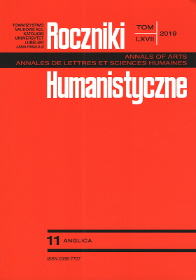An “Unexocentric” Synthetic Account of cut-throat and chimney sweep: Evidence from Polish
Abstract
In English, exocentric compounds, such as chimney sweep and cut-throat do not possess an overtly expressed suffix. Instead, they seem to be composed of a verb and an argument of that verb, e.g. dareVdevilN, shoeNblackV. Naturally, such an interpretation would immediately position the quoted examples among the representatives of root compounding.
We are convinced that zero derivation plays a significant role in the formation of English synthetic compounds in the same way it is seen in Polish. We believe that the research material from Polish offers a substantial amount of evidence for the active participation of conversion in the process of synthetic compounding. This, in turn, accentuates the need to revisit the classification of such formations as spoilsport and chimney sweep, habitually classified as exocentric.
This paper provides an ‘unexocentric’ synthetic account of N-V/V-N compound nouns in English. We believe that a root interpretation of shoeblack and daredevil types does not reflect their genuine structure, which, as we argue, rests on a combination of a nominal and verbal stems followed by a zero affix, being the locus of morphosyntactic features and the semantic referent.
In our analysis, we draw on a revised version of LIH, i.e. Lieber and Scalise’s (2007) Firewall Theory, which belongs to the current of the so-called mixed models of word-formation advanced in the recent years by, for instance, Ackema and Neeleman (2004), Lieber and Scalise (2007), and Pafel (2017), allowing for a limited intermodular interaction between morphological and syntactic domains.
References
Ackema, Peter, and Ad Neeleman. Beyond Morphology: Interface Conditions on Word Formation. Oxford UP, 2004.
Bauer, Laurie. English Word-Formation. Cambridge UP, 1983.
Bauer, Laurie. “Compounding.” Language Universals and Language Typology, edited by Martin Haspelmath, Ekkehard König, Wolfgang Oesterreicher, and Wulf Raible. De Gruyter, 2001, pp. 695–707.
Bauer, Laurie. “Les Composés Exocentriques de l’Anglais.” La Composition dans une Perspective Typologique, edited by Dany Amiot. Artois Presses Université, 2008, pp. 35–47.
Bloomfield, Leonard. Language. Allen and Unwin, 1933.
Botha, Rudolf. “A Base Rule Theory of Afrikaans Synthetic Compounding.” The Scope of Lexical Rules, edited by Michael Moortgat, Harry van der Hulst, and Teun Hoekstra. Foris Publications, 1981, pp. 1–77.
Bisetto, Antonietta, and Sergio Scalise. “Compounding: Morphology and/or syntax?” Boundaries of Morphology and Syntax, edited by Lunella Mereu. John Benjamins, 1999, pp. 31–48.
Booij, Geert. “The Relation between Inheritance and Argument Linking: Deverbal Nouns in Dutch.” Morphology and Modularity: to Honour Henk Schultink, edited by Arnold Evers, Riny Huybregts, and Mieke Trommelen. Foris Publications, 1988, pp. 57–73.
Booij, Geert. “Lexical Integrity as a Formal Universal: A Constructionist View.” Universals of Language Today, edited by Sergio Scalise, Elisabetta Magni, and Antonietta Bisetto. Springer, 2009, pp. 83–100.
Di Sciullo, Anna, and Edwin Williams. On the Definition of Word. MIT Press, 1987.
Fabb, Nigel. Syntactic Affixation. PhD Dissertation. MIT Press, 1984.
Kolbusz-Buda, Joanna. Compounding in Polish and English. A Morpho-Semantic Analysis of Synthetic Deverbal Compound Nouns in Polish in the Light of Parallel Constructions in English. Wydawnictwo KUL, 2014.
Kolbusz-Buda, Joanna. Złożenia Syntetyczne w Języku Polskim. Analiza Formalna. Wydawnictwo Uniwersytetu Przyrodniczo-Humanistycznego, 2019.
Kurzowa, Zofia. Złożenia imienne we współczesnym języku polskim. PWN, 1976.
Lieber, Rochelle. “Argument Linking and Compounds in English.” Linguistic Inquiry 14, 1983, pp. 251–86.
Lieber, Rochelle. Deconstructing Morphology: Word Formation in Syntactic Theory. University of Chicago Press, 1992.
Lieber, Rochelle. Morphology and Lexical Semantics. Cambridge UP, 2004.
Lieber, Rochelle. “English Word-Formation Processes.” Handbook of Word-Formation, Studies in Natural Language and Linguistic Theory 64, edited by Pavol Štekauer and Rochelle Lieber. Springer, 2005, pp. 375–422.
Lieber, Rochelle, and Sergio Scalise. “The Lexical Integrity Hypothesis in a New Theoretical Universe.” On-line Proceedings of the Fifth Mediterranean Morphology Meeting, edited by Geert Booij, Bernardo Fradin, Emiliano Guevara, Angelo Ralli, and Sergio Scalise, 2007, pp. 1–24. https:geertbooij.files.wordpress.com/2014/02/mmm5-proceedings.pdf. Accessed 13 June 2019.
Marchand, Hans. The Categories and Types of Present-Day English Word Formation. a Synchronic-Diachronic Approach. Beck, 1969.
Pafel, Jürgen. “Phrasal Compounds and the Morphology-Syntax Relation.” Further Investigations into the Nature of Phrasal Compounding, edited by Carola Trips and Jaklin Kornfilt, Language Science Press, 2017, pp. 233–259.
Selkirk, Elizabeth. The Syntax of Words. MIT Press, 1982.
Sproat, Richard. On Deriving the Lexicon. PhD Dissertation. MIT, 1985.
Wiese, Richard. “A Two-Level Approach to Morphological Structure.” Journal of Germanic Linguistics 20, 2008, pp. 243–274.
Copyright (c) 2019 Roczniki Humanistyczne

This work is licensed under a Creative Commons Attribution-NonCommercial-NoDerivatives 4.0 International License.





